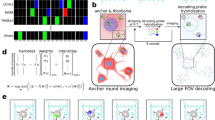Abstract
We have investigated the expression of Fxyd3 and Lgi4 in the adult mouse by Northern blot analyses and in situ hybridization. Murine Fxyd3 and Lgi4 have been mapped to the same locus on mouse Chromosome (Chr) 7, where the last exon of Fxyd3 completely overlaps with the 3’UTR in the last exon of Lgi4, which is transcribed in the opposite orientation. The Fxyd3 gene (formerly called Mat-8) encodes an 8-kDa transmembrane protein that is upregulated in mammary tumors and can induce a chloride conductance upon RNA injection into Xenopus oocytes. Fxyd3 is a member of the Fxyd family of which several members are tissue-specific regulators of ion channels. Murine Lgi4 is a recently described member of the leucine-rich-repeat gene family Lgi. Northern blot analyses demonstrated a 0.6-kb Fxyd3 transcript with abundant expression in the murine skin, colon, and mammary gland, but low level expression in the brain. In contrast, a 3.2-kb Lgi4 transcript was abundant in brain, with lower level expression in colon. Lgi4 transcription in the skin was detectable only by RT-PCR. A Fxyd3-specific sense cRNA probe hybridized to a transcript in Northern blots of brain and colon RNA that co-migrated with the Lgi4 mRNA. In situ hybridization experiments revealed that both Fxyd3 and Lgi4 were expressed in the same tissue compartments in skin, uterus, intestine, mammary gland, and brain. These results demonstrate that Fxyd3 and Lgi4 transcripts potentially form double-stranded RNA molecules in many cell types in vivo, which may impact on their respective expression.



Similar content being viewed by others
References
R Aizman C Asher M Fuzesi H Latter P Lonai et al. (2002) ArticleTitleGeneration and phenotypic analysis of CHIP knockout mice. Am J Physiol Renal Physiol 283 F569–F577 Occurrence Handle1:CAS:528:DC%2BD38XntFOnt7k%3D Occurrence Handle12167609
P Beguin G Crambert S Guennoun H Garty JD Horisberger et al. (2001) ArticleTitleCHIF, a member of the FXYD protein family, is a regulator of Na,K-ATPase distinct from the gamma-subunit. EMBO J 20 3993–4002 Occurrence Handle1:CAS:528:DC%2BD3MXmtlChtrw%3D Occurrence Handle11483503
P Beguin G Crambert F Monnet-Tschudi M Uldry JD Horisberger et al. (2002) ArticleTitleFXYD7 is a brain-specific regulator of Na,K-ATPase alpha 1-beta isozymes. EMBO J 21 3264–3273 Occurrence Handle10.1093/emboj/cdf330 Occurrence Handle1:CAS:528:DC%2BD38XlsFCgt7g%3D Occurrence Handle12093728
C Blin-Wakkach F Lezot S Ghoul-Mazgar D Hotton S Monteiro et al. (2001) ArticleTitleEndogenous Msx1 antisense transcript: in vivo and in vitro evidence, structure, and potential involvement in skeleton development in mammals. Proc Natl Acad Sci USA 98 7336–7341 Occurrence Handle1:CAS:528:DC%2BD3MXkslWmur4%3D Occurrence Handle11390985
F Cornelius YA Mahmmoud HR Christensen (2001) ArticleTitleModulation of Na,K-ATPase by associated small transmembrane regulatory proteins and by lipids. J Bioenerg Biomembr 33 415–423 Occurrence Handle10.1023/A:1010671607911 Occurrence Handle1:CAS:528:DC%2BD3MXnsl2ltbY%3D Occurrence Handle11762917
G Crambert M Fuzesi H Garty S Karlish K Geering (2002) ArticleTitlePhospholemman (FXYD1) associates with Na,K-ATPase and regulates its transport properties. Proc Natl Acad Sci USA 99 11476–11481 Occurrence Handle1:CAS:528:DC%2BD38XmslSlsrc%3D Occurrence Handle12169672
H Garty M Lindzen R Scanzano R Aizman M Fuzesi et al. (2002) ArticleTitleA functional interaction between CHIF and Na-K-ATPase: implication for regulation by FXYD proteins. Am J Physiol Renal Physiol 283 F607–F615 Occurrence Handle12217851
W Gu A Wevers H Schroder KH Grzeschik C Derst et al. (2002) ArticleTitleThe LGI1 gene involved in lateral temporal lobe epilepsy belongs to a new subfamily of leucine-rich repeat proteins. FEBS Lett 519 71–76 Occurrence Handle10.1016/S0014-5793(02)02713-8 Occurrence Handle1:CAS:528:DC%2BD38XjvVSntbs%3D Occurrence Handle12023020
M Guipponi F Rivier F Vigevano C Beck A Crespel et al. (1997) ArticleTitleLinkage mapping of benign familial infantile convulsions (BFIC) to chromosome 19q. Hum Mol Genet 6 473–477 Occurrence Handle10.1093/hmg/6.3.473 Occurrence Handle1:CAS:528:DyaK2sXhvFKrurg%3D Occurrence Handle9147652
M Kumar GG Carmichael (1997) ArticleTitleNuclear antisense RNA induces extensive adenosine modifications and nuclear retention of target transcripts. Proc Natl Acad Sci USA 94 3542–3547 Occurrence Handle1:CAS:528:DyaK2sXis1amtrY%3D Occurrence Handle9108012
JT Lee LS Davidow D Warshawsky (1999) ArticleTitleTsix, a gene antisense to Xist at the X-inactivation centre. Nat Genet 21 400–404 Occurrence Handle10.1038/7734 Occurrence Handle1:CAS:528:DyaK1MXitFKrs7c%3D Occurrence Handle10192391
RC Lee RL Feinbaum V Ambros (1993) ArticleTitleThe C. elegans heterochronic gene lin-4 encodes small RNAs with antisense complementarity to lin-14. Cell 75 843–854 Occurrence Handle1:CAS:528:DyaK2cXpslGqtA%3D%3D Occurrence Handle8252621
B Lehner G Williams RD Campbell CM Sanderson (2002) ArticleTitleAntisense transcripts in the human genome. Trends Genet 18 63–65 Occurrence Handle1:CAS:528:DC%2BD38XovFagug%3D%3D Occurrence Handle11818131
AW Li PR Murphy (2000) ArticleTitleExpression of alternatively spliced FGF-2 antisense RNA transcripts in the central nervous system: regulation of FGF-2 mRNA translation. Mol Cell Endocrinol 170 233–242 Occurrence Handle1:STN:280:DC%2BD3Mvnt1Cjuw%3D%3D Occurrence Handle11162906
BW Morrison P Leder (1994) ArticleTitleneu and ras initiate murine mammary tumors that share genetic markers generally absent in c-myc and int-2-initiated tumors. Oncogene 9 3417–3426 Occurrence Handle1:CAS:528:DyaK2MXisFWrsL8%3D Occurrence Handle7970700
BW Morrison JR Moorman GC Kowdley YM Kobayashi LR Jones et al. (1995) ArticleTitleMat-8, a novel phospholemman-like protein expressed in human breast tumors, induces a chloride conductance in Xenopus oocytes. J Biol Chem 270 2176–2182 Occurrence Handle1:CAS:528:DyaK2MXjsV2ksbo%3D Occurrence Handle7836447
S Schiemann M Schwirzke N Brunner UH Weidle (1998) ArticleTitleMolecular analysis of two mammary carcinoma cell lines at the transcriptional level as a model system for progression of breast cancer. Clin Exp Metastasis 16 129–139 Occurrence Handle1:CAS:528:DyaK1cXit1Crur8%3D Occurrence Handle9514094
J Shendure GM Church (2002) ArticleTitleComputational discovery of sense-antisense transcription in the human and mouse genomes. Genome Biology 3, research 0044.1–0044.14
F Sleutels R Zwart DP Barlow (2002) ArticleTitleThe non-coding Air RNA is required for silencing autosomal imprinted genes. Nature 415 810–813 Occurrence Handle1:CAS:528:DC%2BD38XhsFersrw%3D Occurrence Handle11845212
KJ Sweadner E Rael (2000) ArticleTitleThe FXYD gene family of small ion transport regulators or channels: cDNA sequence, protein signature sequence, and expression. Genomics 68 41–56 Occurrence Handle1:CAS:528:DC%2BD3cXlslCqtLo%3D Occurrence Handle10950925
MH Vaarala K Porvari A Kyllonen P Vihko (2000) ArticleTitleDifferentially expressed genes in two LNCaP prostate cancer cell lines reflecting changes during prostate cancer progression. Lab Invest 80 1259–1268 Occurrence Handle1:CAS:528:DC%2BD3cXmtFOgsrk%3D Occurrence Handle10950117
Acknowledgements
The authors gratefully acknowledge the expert technical assistance of U. Schwaab and G. Eversloh.
Author information
Authors and Affiliations
Corresponding author
Rights and permissions
About this article
Cite this article
Runkel, F., Michels, M. & Franz, T. Fxyd3 and Lgi4 expression in the adult mouse: a case of endogenous antisense expression . Mamm Genome 14, 665–672 (2003). https://doi.org/10.1007/s00335-003-2282-z
Received:
Accepted:
Issue Date:
DOI: https://doi.org/10.1007/s00335-003-2282-z




